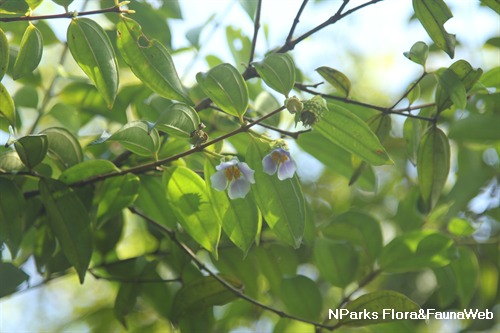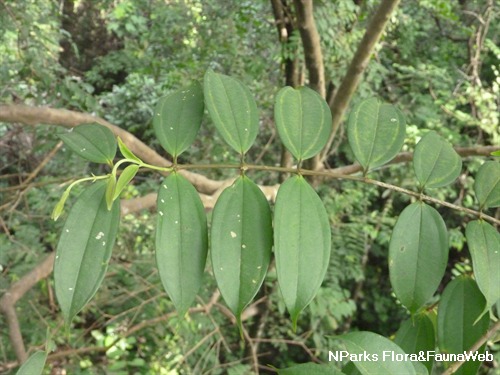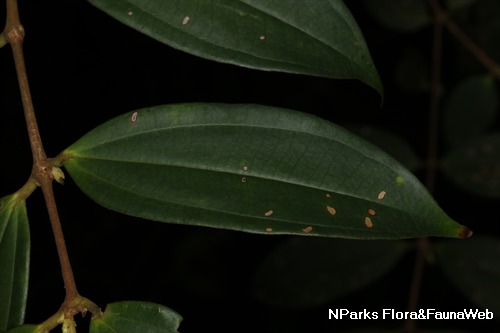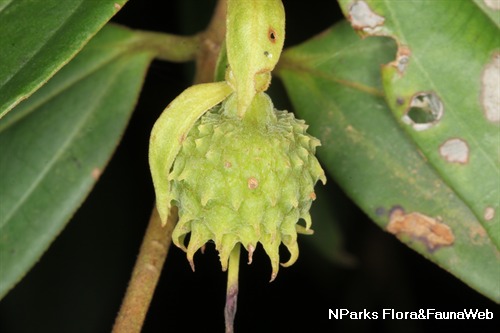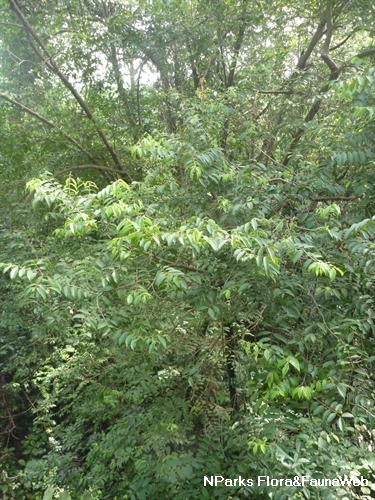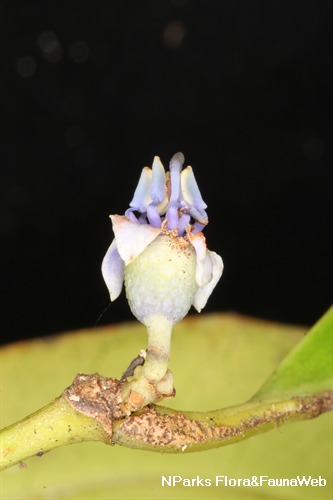
Back
Pternandra echinata Jack
| Family Name: | Melastomataceae |
| Common Name: | Cursed Shade, Sial Menahun, Serai Manuam, Kelat Menahun, Medang Melukut, Menahun, Nahun, Nanas Burung, Sangkak Jantan, Tapak Kuda |
Name
Classifications and Characteristics
| Plant Division | Angiosperms (Flowering Seed Plants) (Dicotyledon) |
|---|---|
| Plant Growth Form | Tree (Medium (16m-30m)) |
| Lifespan (in Singapore) | Perennial |
| Mode of Nutrition | Autotrophic |
| Plant Shape | Irregular |
| Maximum Height | 20 m |
Biogeography
| Native Distribution | Peninsular Thailand, Peninsular Malaysia, Singapore, Riau Archipelago, and Borneo |
|---|---|
| Native Habitat | Terrestrial (Primary Rainforest, Secondary Rainforest) |
| Preferred Climate Zone | Tropical |
| Local Conservation Status | Native to Singapore (Least Concern (LC)) |
Description and Ethnobotany
| Growth Form | It is a tree with droopy leafy twigs, up to 20 m tall. Its 4-angled or 4-winged branchlets are almost hairless to densely clothed with short red brown or light yellow hairs. |
|---|---|
| Foliage | Its opposite, stalked leaves have rather leathery leaf blades that are lance-shaped to elliptic with a pointed tip. The three-veined leaf blades have minute hairs below and are 5.1–12.7 by 1.9–4.5 cm. |
| Flowers | Its 4-merous flowers are either solitary or in clusters of 3–9, with a mildly unpleasant scent. The flowers each have 4 lilac petals, with a bright yellow stamens. Its green calyx has spines up to 5 mm long. |
| Fruit | Its round fruits are berries of 8–20 mm wide. The berries are purplish when ripe. |
| Habitat | It grows in primary and secondary forests up to 1200 in altitude. |
| Associated Fauna | Its flowers are insect-pollinated. |
| Cultivation | It can be propagated by seed. |
| Etymology | Pternandra, heel and stamen, a reference to the spur; echinata, spiny, referring to the plant’s calyx tube with pointed appendages |
| Ethnobotanical Uses | Medicinal: A decoction of the
pounded leaves with that of another plant is administered for coughs and
asthma. Timber & Products: It is a source of timber and has been used as beams. |
Landscaping Features
| Landscaping | It is suitable for parks and gardens for its attractive lilac flowers. |
|---|---|
| Desirable Plant Features | Ornamental Flowers |
| Landscape Uses | General, Parks & Gardens |
Fauna, Pollination and Dispersal
| Pollination Method(s) | Biotic (Fauna) |
|---|---|
| Seed or Spore Dispersal | Biotic (Fauna) |
Plant Care and Propagation
| Light Preference | Full Sun |
|---|---|
| Water Preference | Moderate Water |
| Plant Growth Rate | Moderate |
| Rootzone Tolerance | Moist Soils, Well-Drained Soils, Fertile Loamy Soils |
| Propagation Method | Seed |
Foliar
| Foliage Retention | Evergreen |
|---|---|
| Mature Foliage Colour(s) | Green |
| Mature Foliage Texture(s) | Leathery |
| Foliar Type | Simple / Unifoliate |
| Foliar Arrangement Along Stem | Opposite |
| Foliar Attachment to Stem | Petiolate |
| Foliar Shape(s) | Non-Palm Foliage (Lanceolate, Elliptical) |
| Foliar Venation | Pinnate / Net, Parallel |
| Foliar Margin | Entire |
| Leaf Area Index (LAI) for Green Plot Ratio | 3.0 (Tree - Intermediate Canopy) |
Floral (Angiosperm)
| Flower & Plant Sexuality | Bisexual Flowers |
| Flower Colour(s) | Purple |
|---|---|
| Flower Grouping | Cluster / Inflorescence |
| Flower Location | Axillary |
| Flower Symmetry | Radial |
Fruit, Seed and Spore
| Mature Fruit Colour(s) | Purple |
|---|---|
| Fruit Classification | Simple Fruit |
| Fruit Type | Fleshy Fruit , Non-Accessory Fruit |
Image Repository
Others
| Master ID | 1799 |
|---|---|
| Species ID | 3092 |
| Flora Disclaimer | The information in this website has been compiled from reliable sources, such as reference works on medicinal plants. It is not a substitute for medical advice or treatment and NParks does not purport to provide any medical advice. Readers should always consult his/her physician before using or consuming a plant for medicinal purposes. |

